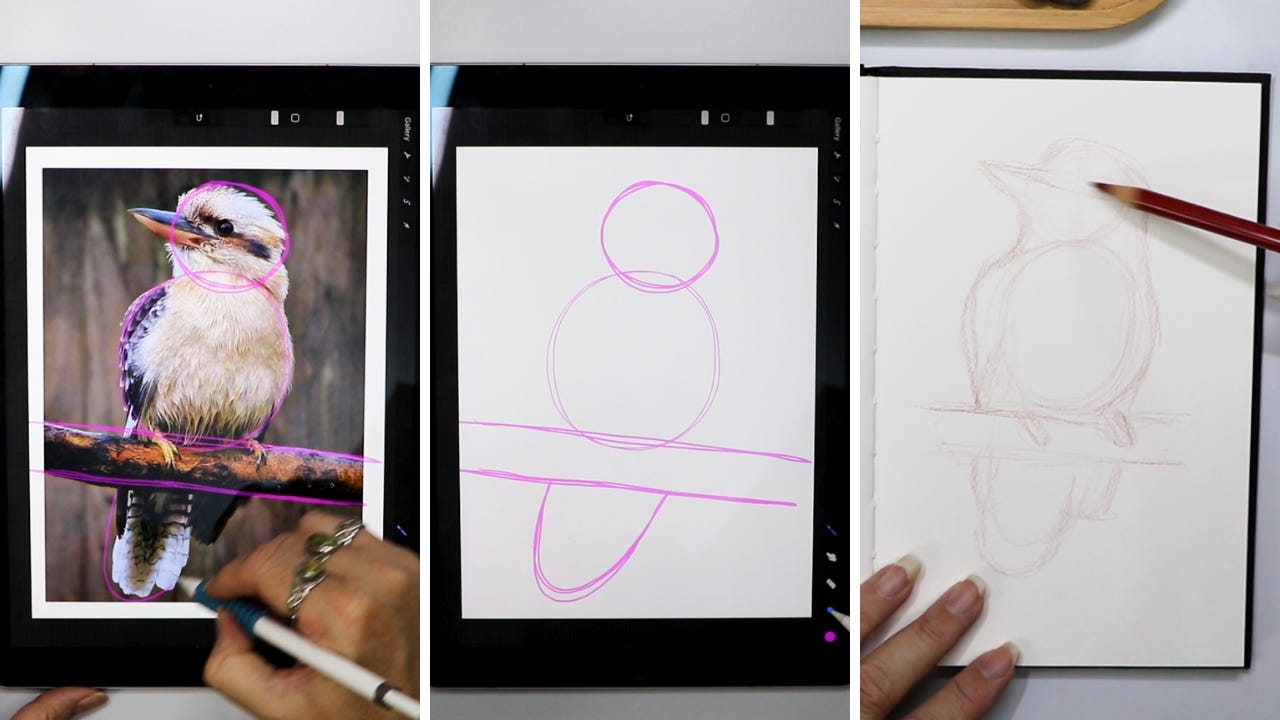Happiest of New Years to you, Dear Wild-Hearted Artist,
I don’t know about you, but I think this year is going to be marvellously creative and abundantly arty - what do you think? Shall we make it happen?
Alright then! Let’s talk shapes today. We need shapes before we build value, after all.
First though, have you ever noticed how much more you see when you get truly curious about something? When you let go of preconceptions and just... observe? Like, really see.
I tend to think about this mostly in the context of art making, wildlife honouring, because it is my jam, but it applies universally. We cannot help but miss out on so, so much, because we are busy little humans.
But to bring it back from broadly philosophical to creative human context, getting curious is right up there in terms of importance for realistic wildlife art-ing.
I've had a pair of kookaburra in my backyard on and off for a few years now. In fact, this last year there were three more than there were two. They are quite big birds, and the also quite big parrots that share the yard with them are not their biggest fans. I think it is their beaks as much as anything. And the sheer determination with which they fly absolutely anywhere. These incredible beings, with their strong, angled beaks and fluffy rounded bodies, raucous laughter, and ability to spot a mole cricket at a hundred paces are a beautiful study in contrasts - both in their physical form and in the way they invite us to observe. Even better, to observe them observing.
Let me share a simple exercise that might shift how you see and draw:
The Two-Minute Shape Study
Choose your reference (any wild being will do, but if you have a Kookaburra photo handy, perfect!)
Set a timer for one minute
Without lifting your eyes from the page, trace the outside edges of your subject with your gaze. Look for the biggest shapes you can find - circles, ellipses, rectangles, half circles. Describe them with words if it helps. Keep your facial muscles loose.
Now grab a pencil, you can turn it around to the blunt back end, and do the same - loose grip and way back on your pencil
Focus more on what you're seeing than what you're drawing
When the timer goes off, look at your page. What shapes emerged? What surprised you?
Reset your timer for two minutes
Now do the same with your pencil, with the pigment side onto paper this time. Use your eyes to work around the image, following with your hands, looking at those biggest shapes.
You are looking for connection, not perfection. You will not have a Rembrandt in a minute. You should have a bunch of shapes that if you squint at, can become the basis for a drawing of a wild being!
This exercise isn't about creating a perfect drawing. It's about training our eyes and hands to work together, to really see shapes before we start building value and detail. It's about embracing curiosity over judgment.
For a deeper dive into this approach and a Kookaburra drawing tutorial, I've posted a new video on YouTube ⬇️ where we explore this process together. And if you'd like even more detail about finding shapes and building value in your wildlife art, I've written a full blog post with additional tips and insights.
Remember, every time you pick up your pencil with curiosity rather than judgment, you're strengthening your connection not just to your subject, but to your own creative wild heart.
Keep sketching!







I love this exercise--now that I am drawing again after decades of not drawing, I am really seeing things differently. Thanks for this.